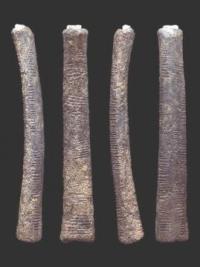Practical Nutrition+ Vol 01 No 01

Practical Nutrition+ (tm)
Vol 1, No. 1
February, 1995
Copyright 1995 by Dennis Denlinger
ALL RIGHTS RESERVED
"Practical Nutrition+" is a monthly electronic newsletter about care of the human body. Over the past 20 years the Editor, Dennis Denlinger, has been researching how to care for his own body with much success. During this time many theories and methods have been investigated and tried. Some have worked and some haven't. Some which have worked have been replaced with others which have worked better. Even more subjects have been researched than have been tried.
Suggestions, gripes, questions and other feedback, addressed to Editor, "Practical Nutrition+" at denlingr@ix.netcom.com are welcome. Also, experts and people with practical experience with various areas of health are welcome to contribute guest articles. Contributors will be acknowledged by listing their Name, Firm Name, Street Address, Phone Number and E-mail address.
The content of "Practical Nutrition+" is determined by the Editor, with due weight being given to your input. It will include from time to time articles by Dennis Denlinger or other lay persons who have had practical experience in day-to-day nutrition, articles by health care professionals, book reviews, answers to your questions and perhaps some surprises.
>>>"Practical Nutrition+" does NOT give advice, but is only intended to inform, to entertain and to be a place where ideas regarding health can be exchanged. If you have a specific health problem, consult an appropriate licensed health care practitioner.<<<
"Practical Nutrition+" will be available at various locations around the Internet. To subscribe to the electronic version of "Practical Nutrition+" send both your e-mail and paper mail addresses to denlingr@ix.netcom.com or to Dennis Denlinger, P.O. Box 60431, Sacramento, CA 95860-0431, USA. Your address will Not be distributed to others, but we may send you other pertinent information from time to time.
Introduction to the Editor
The consensus among health care practitioners is more and more that much non-optimum health originates with a lack of adequate nutritional value in our food or with the intake of toxic substances which reduce the body's functions. There are, indeed, other factors such as exercise, injury, birth defects, elimination of waste and mental state which affect physical health. However, the major factor is daily intake, good and bad intake. And health does not mean just lack of illness, but a robust, well-toned and well-feeling body.
The route I took to nutrition was somewhat convoluted. During many of my growing and young adult years I had chronic headaches. M.D.s did CAT scans of my head and chiropractors adjusted my spine and skull. I tried aspirin, pain killer drugs and nutritional supplements such as calcium and magnesium. Nothing worked.
Then one day a chiropractor showed me a diagram of muscles in the neck. WOW! Are Those things really there? But...but...but...I'm Not using Those muscles...those muscles right There (finger pointing). I went home and started right away on getting those muscles working. The headaches lessened. I bought a copy of "Gray's Anatomy" and started studying muscles in the spine. Eventually I found and corrected over 15 atrophied or paralyzed or incorrectly-functioning muscles in my neck alone. The structural engineering I learned while earning my architectural degree really came in handy! Needless to say, I have handled many of my body's structural problems and the remainder are progressing nicely.
There was a large amount of data collected. An organizational system to the muscles and bones of the human body was discovered. At first I was going to write a paper, but there was too much material and a book resulted. That was ten years ago.
Included in the book was a section on nutrition. When people found out what I was doing, they started flooding me with information about health and nutrition. That was the beginning of my study of nutrition. I did more than just learn. I actually applied what I learned to myself and my family.
Six years ago, when my son was in the womb, we were already doing well at nutrition. But, we decided to do better and made some basic rules: 1) No refined sugar - ever; 2) No preservatives such as the sodium nitrite and sodium nitrate found in ham and lunch meats; 3) No refined foods such as white bread, white flour or white rice - instead use whole foods; 4) No additives such as food colorings, artificial flavor or substances with unrecognizably complex names.
It paid off. The Apgar Score is a means of rating a newborn baby's condition at 1 minute and 5 minutes of age. It is based on simple, easy to observe factors such as breathing and skin color. The rating is from 1 for stillborn to a top of ten. My son had an Apgar Score of 9 in a drugless birth, which is Very good.
When my daughter was in the womb 3 years ago, we shifted to totally organic foods. Ever since then, all the produce, fruits, grains, bread, legumes, etc. we buy is grown organically according to California State Law. This was in addition to the program instituted for my son.
It also paid off big. First of all, with no other changes and without trying to do so, I lost 15 pounds in the first 3 months of instituting the totally organic program. Prior to that I was obviously over weight. Then my daughter was born drugless attended by myself and a mid-wife after only 2 hours of labor. The Apgar Score for my daughter was a 10 At One Minute! The mid-wife said she rarely gave a 10 at 5 minutes, but Never at 1 minute...until Lindsay was born.
Yes, the nutrition and body health (Health - not merely lack of disease) theory I have learned did not sit on a dusty shelf, but was applied in life with excellent results. I feel it is my duty to let others know about my experiences and the experiences of others along with the principles which are being applied. The material must be written simply for the average layman, not complexly for the research biochemist. Most importantly, it must be possible to do. Growing sun potatoes in a garden patch on the moon is not exactly do-able. Replacing refined white bread with whole grain bread is within reach for most people.
So, I am now publishing the "Practical Nutrition+" Newsletter. Included will be easy-to-understand theory and how the theory is being applied in real life by real people. The theory will concentrate on basic principles, not complex details. For this, I will welcome submittals by professional and lay readers. Books which I consider important will be reviewed. Promising new data will be presented. There will also be a section in which reader's questions are answered. The "Practical Nutrition+" Newsletter will be between 10,000 and 20,000 bytes in length. I hope to publish it monthly. It will be available on FTP and by e-mail directly to subscribers. If you wish to subscribe, send me your e-mail And snail mail addresses. Your address will Not be released to others, but from time to time I may send out items which I feel will be of interest to my readers.
Your thoughts and comments are important to me. "Practical Nutrition+" cannot survive in a vacuum. Even if I do not have space to include your submittal, letter or question in an issue of the newsletter, I will attempt to answer every piece of e-mail.
PS- Please do Not ask me to diagnose or prescribe for your ills.
If you are sick, go see an appropriate health care professional.
First Come, First Served
When the dinner bell rings and the cook calls, "Come and get it!" for Sunday dinner on the farm, anyone who is late runs the risk of not finding any food left on the table. You run the same risk every time you sit down to eat. There are many other life forms interested in eating your dinner Before you do. One group of these life forms is called bacteria (definition: microscopically small organisms which like to eat nutritious food).
When bacteria eat your food before you do, we say that the food has spoiled. The bacteria's waste products, just like the waste from your own body, do not smell or taste good. There are numerous ways to keep the bacteria from eating the food before you do. The most obvious way is to eat immediately upon harvest. However, this is not always possible. You may want to eat long after the harvest. Or the harvest location may be far from your present location. In these cases, humans, being smarter and better equipped than bacteria, do things to prevent the tiny competitor from eating the food first.
One effective way is refrigeration. Bacteria do not eat, nor grow, so well in a cold environment.
Drying is another effective way to keep bacteria from eating the food first. This works particularly well for seed-type food such as wheat, corn, rye, barley and other grains and for peas, beans, lintels and other legumes. Bacteria need moisture to survive and do not grow well in a dry environment. If the dried grains or legumes will sprout when planted and watered, you know that they are still viable as a food.
However, humans are doing the same as shooting themselves in the foot with some of the ways they use to keep bacteria from getting a meal first. The bacteria are laughing themselves silly over this.
One way humans "shoot themselves in the foot" is to take much of the nutrition out of the food. Bacteria may be small and may have no brains, but when it comes to eating good food, they are Not dumb. They will not eat food which has had the nutrition removed. Such material no longer meets the definition of food. For instance, bacteria do not like to eat white bread or white rice or white flour. Why? There is not enough nutrition to support life. The parts of the grain with the most nutrition has been removed. True, the baker often adds some synthetic vitamins back into the bread, but it does not come close to replacing all the natural vitamins and minerals which were taken out.
Now consider this: If there is not enough nutrition in white flour, white bread or white rice for bacteria to live on, how can humans expect to live on it? Huh??
Another way humans "shoot themselves in the foot" is to put chemical preservatives in the food to kill the bacteria by poisoning. This way the bacteria are too dead to eat the food.
Now consider this: If the chemical preservative kills the bacteria by poisoning, what does it do to Our bodies when We eat the food? Huh??
There is a moral in this. If you want to know what food is best for you to eat, eat the food which bacteria love to eat - but eat it First.
by Dennis Denlinger
Answers to Your Questions
Start sending in the questions and answers will be provided, or at least attempted.
Book Recommendation
There is a classic nutritional study which many people do not know about. During the decade of the 1930's Dr. Weston Price, a dentist from Cleveland, Ohio, studied a dozen primitive cultures who at the time were abandoning their traditional diets in favor of modern diets. The new diets consisted of refined foods, sugar, chemically preserved foods, canned foods and foods grown in soils depleted of minerals. Dr. Price wrote his research up in a book entitled "Nutrition and Physical Degeneration" (Current Publisher: Price-Pottenger Nutrition Foundation, San Diego, CA & La Mesa, CA)
Dr. Prices main statistical research tool was a count of decayed teeth in the mouths of the people he studied. The reason is that tooth decay is generally the first of the degenerative diseases to manifest itself and is easily observable. Dr. Price found from 1/2% to 4% tooth decay in the thousands of teeth he observed of people living on primitive diets. Compare that to the 30% to 50% tooth decay he found in the mouths of people living on modern diets. The people he observed eating primitive diets were often living next door to, and sometimes even in the same family with, people living on modern diets.
He also found that people living on primitive diets had well formed skeletal structures. People living on modern diets had deformed skeletal structures such as crowded or displaced teeth which in our present culture would require braces, disproportioned skulls such as over or under developed chin or forehead and poor development in other bones.
One of the major things he found was the depletion of minerals from the soils. This problem shows up in animals as well as in humans. One farmer told him of a major reduction in the number of cows an acre of land would support over a period of just a few decades.
His report that people living on the primitive diets were invariably of pleasant disposition is very interesting.
The book has an abundance of photographs illustrating Dr. Price's findings. It is not overly full of scholarly words and in general I found it to be very readable. For an overview, just leafing through and reading the captions on the photographs is enlightening. Although this is not a report on "new" research, it covers the basics of nutrition. I doubt that the study could even be done today as there may be no people left living on primitive diets. The book can be found in some public libraries.
by Dennis Denlinger
********************************************
"Practical Nutrition+" is produced and edited by Dennis Denlinger. From time to time I have data on my favorite subjects, publications (I operate a publishing house) or products which I can send you. Some goes best by e-mail and some goes best by snail mail. I will have a summary of my current "nutrition hat," covering basic concepts and how I am presently applying them, available soon via e-mail. Eventually it all will appear in "Practical Nutrition+." For specific requests or potluck, send your e-mail and snail mail addresses to denlingr@ix.netcom.com. or snail mail to Dennis Denlinger, P.O. Box 60431, Sacramento, CA 95860-0431, USA, or telephone (916) 485-5119. I may ask for postage on some snail mail requests.



















